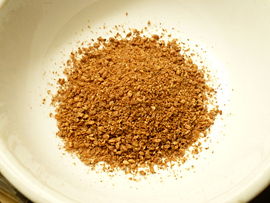
Gomashio
Encyclopedia

Condiment
A condiment is an edible substance, such as sauce or seasoning, added to food to impart a particular flavor, enhance its flavor, or in some cultures, to complement the dish. Many condiments are available packaged in single-serving sachets , like mustard or ketchup, particularly when supplied with...
, similar to furikake
Furikake
is a dry Japanese condiment meant to be sprinkled on top of rice. It typically consists of a mixture of dried and ground fish, sesame seeds, chopped seaweed, sugar, salt, and monosodium glutamate...
, made from unhulled sesame seeds
Sesame
Sesame is a flowering plant in the genus Sesamum. Numerous wild relatives occur in Africa and a smaller number in India. It is widely naturalized in tropical regions around the world and is cultivated for its edible seeds, which grow in pods....
(ごま, goma) and salt
Edible salt
Salt, also known as table salt, or rock salt, is a mineral that is composed primarily of sodium chloride , a chemical compound belonging to the larger class of ionic salts. It is essential for animal life in small quantities, but is harmful to animals and plants in excess...
(塩, shio). It is often used in Japanese cuisine, such as a topping for sekihan
Sekihan
Sekihan , literally red rice, is a Japanese traditional dish. It is sticky rice steamed with azuki beans, which give a reddish color to the rice, hence its name....
. It is also sometimes sprinkled over plain rice or over an onigiri
Onigiri
, also known as or rice ball, is a Japanese food made from white rice formed into triangular or oval shapes and often wrapped in nori . Traditionally, an onigiri is filled with pickled ume , salted salmon, katsuobushi, kombu, tarako, or any other salty or sour ingredient as a natural preservative...
. Some commercially sold gomashio also has sugar mixed in with the salt.
The sesame seeds used to make gomashio may be either tan or black in color. They are toasted before being mixed together with the salt. Occasionally the salt is also toasted. The ratio of sesame seeds to salt varies according to taste and diet, generally ranging between 5:1 (5 parts sesame seeds to 1 part salt) and 15:1. Gomashio is often homemade, though it is also commercially available in glass or plastic containers.
Gomashio is also a part of the macrobiotic diet
Macrobiotic diet
A macrobiotic diet , from "macro" and "bios" , a dietary regimen which involves eating grains as a staple food supplemented with other foodstuffs such as local vegetables avoiding the use of highly processed or refined foods and most animal products...
, where it is used as a more healthful alternative to ordinary salt. Generally, the gomashio used in macrobiotic cuisine will contain less salt than traditional Japanese gomashio (a ratio of 18 parts sesame seeds to 1 part salt is recommended for some individuals with a particularly restricted diet) and made by hand grinding in a suribachi
Suribachi
Suribachi and surikogi are a Japanese mortar and pestle. These mortars are used in Japanese cooking to crush different ingredients such as sesame seeds....
.
Gomashio is also used in the Japanese language
Japanese language
is a language spoken by over 130 million people in Japan and in Japanese emigrant communities. It is a member of the Japonic language family, which has a number of proposed relationships with other languages, none of which has gained wide acceptance among historical linguists .Japanese is an...
to refer to describe a head of hair containing both white and black hair strands that intermingle, similar to the English idiom "salt and pepper".

